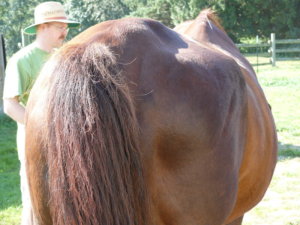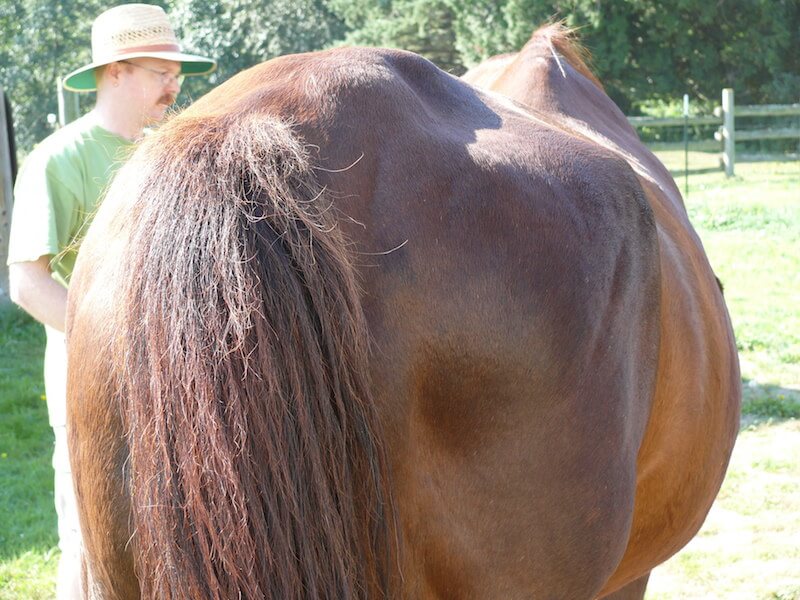Understanding Equine Protozoal Myelitis
by R. Paul Schwab, DVM
Equine Protozoal Myelitis, or EPM, is a neurologic disease of horses caused by a parasite called Sarcocystis neurona, or less frequently by Neospora hugesi. Horses acquire the parasite from ingesting feed or water contaminated with feces of infected opossums. The migrating phase of parasite enters through the intestine and enters the blood stream settling in white blood cells and neurons (nerve cells in the brain and spinal cord). When the organism begins to multiply it kills the cells causing inflammation and swelling in that area usually in the spinal cord, but can also damage the brain.

Clinical signs can be quite variable, especially early on, and is largely dependent on where the organism resides in the nerve tissue and the horse’s ability to fight the infection. Infections tend to be in the spinal cord more commonly. Often the first complaint from the owner is for lameness or muscle atrophy or wasting on one or more muscle groups. As the disease progresses, horse can become extremely ataxic, or wobbly, and in severe cases are down and can’t get up. If the organism settles in the brain, the horse may have a head tilt, droopy face and/or tongue, or even seizure activity. Although not always, horses with EPM typically have problems only on one side of the body (unilateral).
As with any disease, the first order of business is to stabilize the horse and limit damage from the disease. With neurologic disease it’s extremely important to have them in an area that the horse can’t hurt itself, i.e. deeply bedded stall, flat ground, possibly near an area to attach a sling if horse becomes recumbent. We usually start these horses on potent anti-inflammatory drugs such as phenylbutazone (“bute”) or flunixin (Banamine). Remember, the damage to the horse is the inflammation that occurs while the parasite multiplies and kills cells. Although somewhat controversial, corticosteroids are often used early on in the disease because of its powerful anti-inflammatory effects, especially in the neurologic system, and because other types of spinal cord damage respond well to corticosteroids.
There are a few commercially available anti-protozoal drugs that kill the organism responsible for EPM. Treatment can be expensive and horses must be treated for several weeks if not months. For this reason it is very important to have an accurate diagnosis before initiating the full treatment regimen. Blood tests are available but must be interpreted very carefully. Depending on the source cited, 45% of horses around the country may have positive antibody titers to S. neurona. Positive antibody titers only mean the horse has been exposed to the organism, not necessarily has had the disease. As a side note there is a <1% incidence of clinical disease on these positive animals. A newer antibody test measures the amount of antibody in the blood with a probable correlation that a high titer is more likely from actual disease. Testing cerebrospinal fluid makes a more definitive diagnosis, although collection of this fluid can be dangerous in a field setting and contamination of fluid with blood can give false positive results.
Diseases that can be confused with EPM include traumatic neck injuries, tumors of the spinal cord or vertebrae, cervical vertebral malformation also known as “wobblers’ syndrome,” and equine herpes virus (myeloencephalopathy). You may remember the last one from the outbreak that occurred in 2011 following a cutting horse show in Utah. Another very serious condition that can be confused with EPM in certain parts of the country is rabies. Rabies in horses can be very difficult to diagnose early on. Like EPM, rabies in horses can present with very vague signs such as an odd lameness.
If diagnosed early in the course of the disease, EPM can be treated and the horse can recover although complete return to function is variable depending on the amount of damage to the horse. Horses that are down have a much more grave prognosis unless they can be maintained in a sling. Even in these circumstances it is difficult to get the horse safely walking again.
Control of EPM is solely based on preventing contamination of grain, hay, and water from opossums. A few years ago, there was a vaccine available on a conditional license, but its efficacy was not enough to continue to manufacture. Talk to your veterinarian if you have questions about EPM and especially if your horse seems uncoordinated or is losing muscle in one or more muscle groups.
Published April 2013 Issue

The Northwest Horse Source is an independently owned and operated print and online magazine for horse owners and enthusiasts of all breeds and disciplines in the Pacific Northwest. Our contemporary editorial columns are predominantly written by experts in the region, covering the care, training, keeping and enjoyment of horses, with an eye to the specific concerns in our region.






